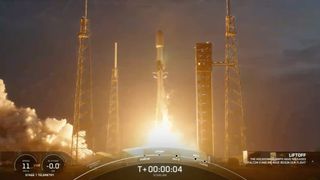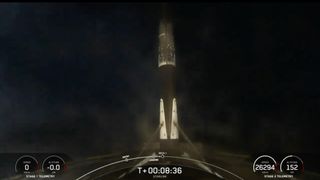SpaceX launched another batch of its broadband satellites to orbit this evening (March 25).
A Falcon 9 rocket carrying 23 of SpaceX's Starlink internet satellites lifted off from Cape Canaveral Space Force Station in Florida today at 7:42 p.m. EDT (2342 GMT).
The Falcon 9's first stage came back to Earth as planned, acing its vertical landing about 8.5 minutes after liftoff on the SpaceX drone ship A Shortfall of Gravitas, which was stationed in the Atlantic Ocean.
Related: Starlink satellite train: How to see and track it in the night sky

It was the eighth launch and landing for this particular booster, according to a SpaceX mission description.
The Falcon 9's upper stage, meanwhile, will deploy the 23 Starlink satellites into low Earth orbit (LEO) about 65 minutes after liftoff, if all goes according to plan.

Today's launch was the 29th Falcon 9 mission of 2024 already, and the 19th devoted to building out the Starlink megaconstellation. Before this liftoff, SpaceX had launched 6,054 Starlink satellites, 5,587 of which are currently operational in LEO, according to astrophysicist and satellite tracker Jonathan McDowell.
Get the Space.com Newsletter
Breaking space news, the latest updates on rocket launches, skywatching events and more!
Join our Space Forums to keep talking space on the latest missions, night sky and more! And if you have a news tip, correction or comment, let us know at: community@space.com.

Michael Wall is a Senior Space Writer with Space.com and joined the team in 2010. He primarily covers exoplanets, spaceflight and military space, but has been known to dabble in the space art beat. His book about the search for alien life, "Out There," was published on Nov. 13, 2018. Before becoming a science writer, Michael worked as a herpetologist and wildlife biologist. He has a Ph.D. in evolutionary biology from the University of Sydney, Australia, a bachelor's degree from the University of Arizona, and a graduate certificate in science writing from the University of California, Santa Cruz. To find out what his latest project is, you can follow Michael on Twitter.
